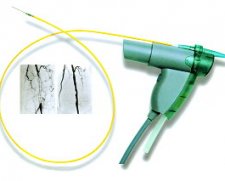
Categorised under:
Interventional Radiology
>
Vascular
>
Thrombectomy
The Straub Rotarex (Straub Medical, Wangs, Switzerland) catheter is a mechanical thrombectomy device designed for the treatment of acute and sub acute thrombotic occlusions in peripheral arteries, stents and grafts. It provides the combination of mechanical fragmentation with aspiration of material to attempt to minimise the risk of embolisation.
The Straub Rotarex ( Straub Medical, Wangs, Switzerland) catheter is a mechanical thrombectomy device designed for the treatment of acute and sub acute thrombotic occlusions in peripheral arteries, stents and grafts. It provides the combination of mechanical fragmentation with aspiration of material to attempt to minimise the risk of embolisation.
The catheter consists of two cylinders with side slits. The inner cylinder is fixed to the catheter shaft and the outer cylinder to a rotating spiral driven by an electric motor at 40-60,000 revs per minute. The rotation at this speed causes negative pressure and occlusion material is sucked into the aspiration slits where it is macerated and then aspirated. Aspiration material is transported up the catheter by the rotating spiral into an aspiration bag.
The device runs over the wire and two different sizes are available, 8 French and 6 French. The 6 French version is used for smaller vessels, usually below the knee. There is a slightly more flexible version available which allows for cross-over the aortic bifurcation.
The system is relatively easy to set up with a control unit which regulates the speed of the motor. The motor is connected to the control unit and subsequently the Rotarex catheter is attached to the motor using a drape to maintain sterility. A foot switch is then used to activate the device. The device does take several minutes to set up, particularly on ones first attempt. However, once ready, the procedure is normally very rapid with the passage of the device over a 0.018in guidewire. The catheter is passed through the occlusion using forward and backward movements progressing at about 1cm per second. The 8 French device appears to be more successful down to the popliteal level, but we have used the 6 French device below the knee joint.
In our initial series of 11 patients we had good technical success in 10. Most cases are accompanied by additional angioplasty and or stenting – see example.
The Rotarex device, we believe, is a useful alternative to thrombolysis in the setting of acute or sub acute thrombotic occlusion. Once familiar with the set up of the device the procedure is very rapid with a high degree of technical success. Its design allows clearance of thrombus more than just the diameter of the catheter and, in our small series, in combination with additional angioplasty and or stenting it has a high technical success rate.
Dr Peter Ellis
Consultant Radiologist, Belfast
No conflict declared.

Did you know you can Register for FREE with this website?
Registration gives you full access to all of the features of WhichMedicalDevice. Find out more ...
WhichMedicalDevice is a FREE resource created by clinicians for clinicians.
Registration is free and gives you unlimited access to all of the content and features of this website.
Find out more...Registration is free and gives you unlimited access to all of the content and features of Which Medical Device. Find out more...
Which Medical Device is a community of clinicians sharing knowledge and experience of the devices and procedures we use on a daily basis. We ask that our members register with us so that we can maintain the unbiased and independent nature of our content. Registration is quick and free.
We do not make your details available to any third parties nor do we send unsolicited emails to our members. You can read our Privacy Policy here.